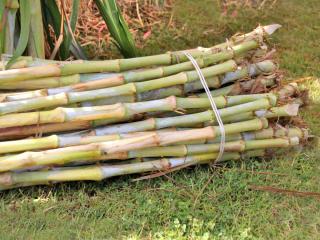

Bana grass is a specific hybrid of Pennisetum. Its amazing growth power makes it suitable for many purposes, from tall grass hedge to fuel and fodder.
Basic Bana grass facts
Name: Pennisetum purpureum x americanum
Common names: bana grass, elephant grass, sugarcane grass
Family: Poaceae
Type: grass
Height – 3 to 13 feet (1 to 4 m)
Exposure – full sun
Foliage – deciduous in cold weather
Flowering – July to October
Soil – poor to rocky to rich
A surprising alternative to more conventional hedges, bana grass can grow quite tall within months. It won’t survive the cold, though, so this plant is for mild-to-tropical climates.
Best start planting bana grass in spring in temperate climates, to give it time to grow. In warmer regions, plant throughout the year, but, if possible, favor the rainy season to make watering easier.
Since bana grass is an easy plant to please, it can grow in any type of soil, even extremely poor, rocky or stiff slopes.
For marcotting, layering and stem cuttings, check that at least one node is under the soil level. Roots and leaves will sprout from the nodes.
In colder climates, cut back dried leaves at the beginning of spring to regenerate the plant.
In warmer climates, bana grass can grow extremely fast.
Bana grass doesn’t fear dry spells once its roots have sprouted, which is why it is great for growing in places that are hard to irrigate.
Bana grass grows extremely rapidly in proper conditions. It also fares better than most other grasses even in a poor growing environment.

A very beautiful perennial that grows in tropical areas, bana grass is native to Africa but is increasingly grown in Asia. It was first developed in the 1950s and has constantly been the object of research to better understand its potential. It’s considered more digestible by livestock than Napier grass, its parent plant.
This plant can grow tall and dense in harsh, poor, dry environments and is easily propagated.
Bana grass is a hybrid variety of Napier grass, Pennisetum purpureum and Pennisetum americanum. There are many varieties, for example ‘Purple Bana grass’.
Babala and Napier, the local names of the parent grasses, gave the new name: “Bana grass”.
Read also:
This is so incredibly Wonderful. Thank you very much for the information.
Thanks for the information.
Thanks for the info, eager to see this wonder plant.
I can get even one cutting to plant in Eldoret
Where can I get bana grass seedlings [stems]
Hello Reon, a lot of research was done by the University of Pretoria. Perhaps they could tell you where it’s being currently grown in South Africa, or they might have samples available or experimental plots you could visit.
Another option is to ask your local seed store or seed producer, they have the local networks you would need to find bana grass cuttings.
A last option is connect to co-ops and / or local permaculture groups. Since bana grass is a great help for their concerns, they’re likely to find ways to help you out.
Hope this helps!